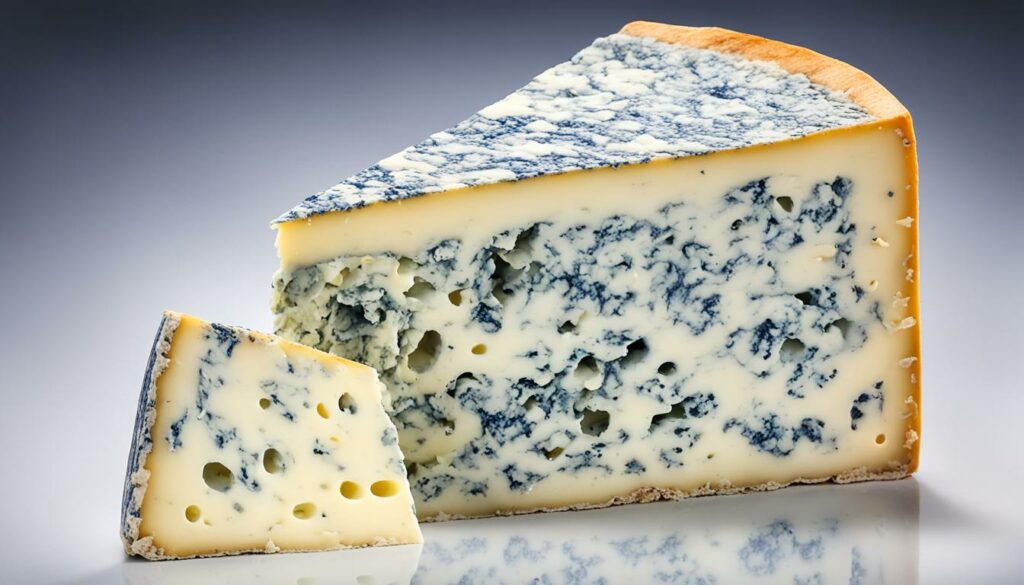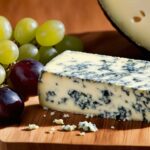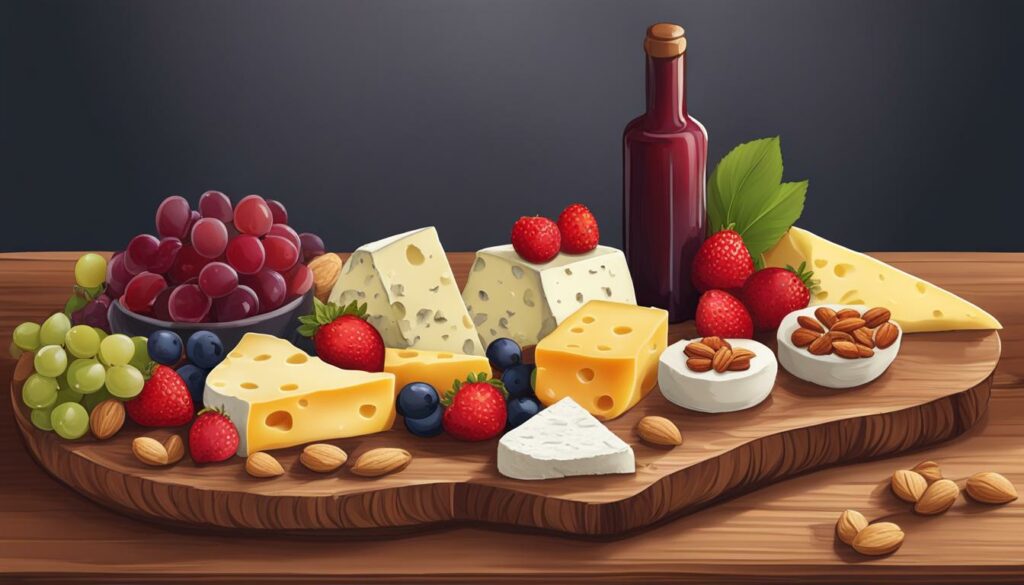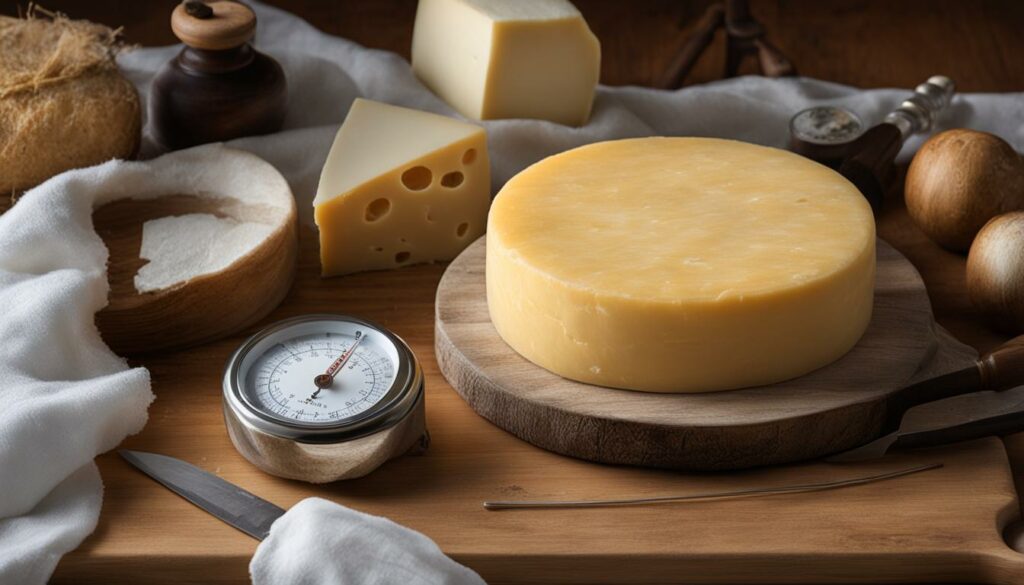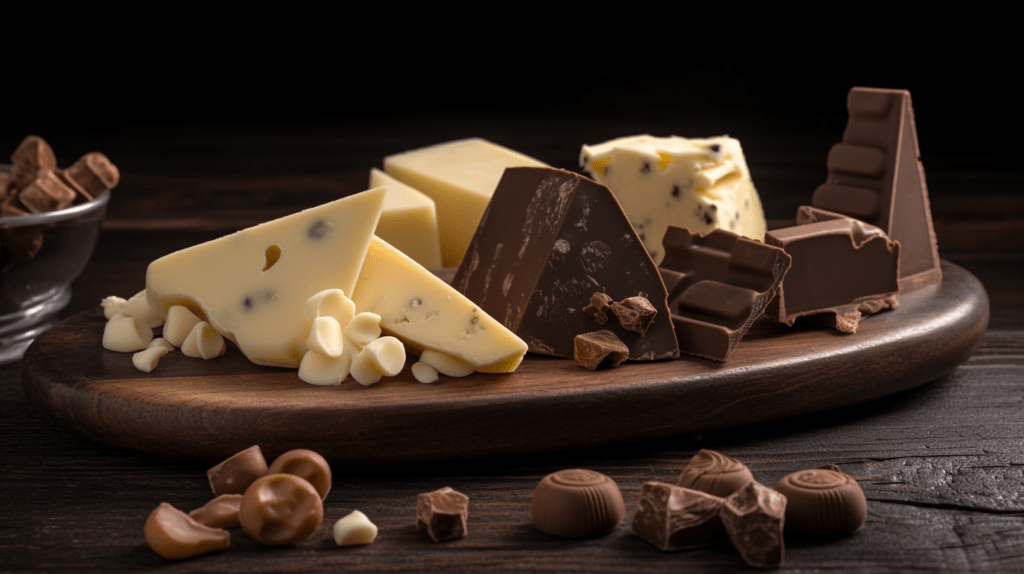Discover the rich and captivating world of artisanal blue cheese with Big Rock Blue Cheese. From the moment you unveil its unique riddling of blue-green mold to the first taste of its delightfully sharp flavor, this gourmet cheese will leave you wanting more.
Renowned for its quality and craftsmanship, Big Rock Blue Cheese stands out as one of the finest blue cheeses in the market today. Each wheel is carefully aged, allowing the flavors to develop and intensify, resulting in a truly exceptional cheese experience.
Whether you’re a cheese connoisseur or simply looking to elevate your culinary creations, Big Rock Blue Cheese is the perfect choice. Its bold flavor profile lends itself well to a variety of dishes and pairings, making it a versatile addition to any gourmet spread.
Indulge in the bold and unforgettable taste of Big Rock Blue Cheese. Immerse yourself in the aromatic qualities and distinctiveness of this artisanal cheese, and experience the true essence of gourmet blue cheese.
The Captivating World of Blue Cheese
Blue cheese, with its rich history and distinctive flavors, has captured the hearts of cheese lovers around the world. Originating in ancient France, blue cheese was born from the accidental discovery of blue mold in aging wheels of cheese. The unique and bold flavor created by this mold has since been refined and perfected, resulting in a diverse selection of blue cheese varieties.
From the sharp tanginess of Roquefort to the mellow yet robust character of Stilton, blue cheese offers a captivating range of flavors for cheese tasting enthusiasts. Each type of blue cheese has its own personality, appealing to different palates and culinary preferences.
But blue cheese isn’t just delicious on its own. Its versatility shines in the world of cheese pairing, where it can elevate a variety of dishes and ingredients. Crumble blue cheese over crisp salads for a burst of tangy richness, or melt it into creamy pasta sauces for a flavorful twist. Blue cheese is also a highlight in gourmet burgers, adding a savory depth to every bite.
When it comes to pairings, blue cheese effortlessly complements fruits, nuts, and even certain types of wine and beer. The contrasting textures and flavors create a harmonious balance that delights the taste buds. Whether it’s a refreshing apple or a robust red wine, blue cheese has the remarkable ability to enhance the overall gastronomic experience.
“Blue cheese is a culinary delight that awakens the senses with its distinct flavors and versatility in pairings. Its tangy and creamy profile adds depth to various dishes, making it a favorite among cheese enthusiasts.”
As you indulge in the captivating world of blue cheese, take a moment to savor the intricate flavors and appreciate the craftsmanship that goes into each wheel. Blue cheese truly is a testament to the artistry and passion of cheesemakers.
Now, let’s explore the nutritional value and pricing of blue cheese in the next sections to have a comprehensive understanding of this delectable cheese.
| Blue Cheese Variety | Description |
|---|---|
| Roquefort | French blue cheese known for its strong and tangy flavor. |
| Stilton | English blue cheese with a rich and creamy texture. |
| Gorgonzola | Italian blue cheese characterized by its crumbly consistency and mild yet pronounced taste. |
Pricing and Nutritional Value of Blue Cheese
When it comes to blue cheese, the price can vary depending on several factors. Artisanal and specialty blue cheeses, crafted with meticulous care and attention, tend to command a higher price compared to mass-produced options. Factors such as the type of cheese, its origin, brand reputation, and overall quality contribute to the pricing.
Now, let’s talk about the nutritional value of blue cheese. While it offers a delightful taste and indulgent experience, it’s essential to be mindful of its nutritional composition. Blue cheese is a good source of protein and calcium, making it a nutrient-rich choice. Moreover, it provides essential vitamins like A and B12.
However, it’s important to note that blue cheese is relatively higher in calories and sodium compared to some other cheese varieties. As with any food, moderation is key when enjoying the scrumptious flavors of blue cheese.

Blue Cheese Pricing Insights
To help you navigate the diverse world of blue cheese pricing, here’s an overview of possible price ranges:
| Blue Cheese Type | Pricing Range (USD) |
|---|---|
| Mass-produced blue cheese | $5-$10 per pound |
| Artisanal and specialty blue cheese | $15-$30 per pound |
| Imported gourmet blue cheese | $20-$40 per pound |
Nutritional Value of Blue Cheese
Here’s a breakdown of the nutritional value per 1-ounce (28-gram) serving of blue cheese:
- Calories: 100-150
- Protein: 6-8 grams
- Fat: 8-10 grams
- Saturated Fat: 4-6 grams
- Carbohydrates: 1-2 grams
- Sodium: 350-450 milligrams
- Calcium: 150-200 milligrams
- Vitamin A: 6-8% of the Recommended Daily Intake (RDI)
- Vitamin B12: 10-15% of the RDI
Tip: Incorporate blue cheese into a balanced diet alongside other nutrient-rich foods to fully enjoy its flavors while maintaining a well-rounded approach to nutrition.
The Bold Flavor of Blue Cheese Mold
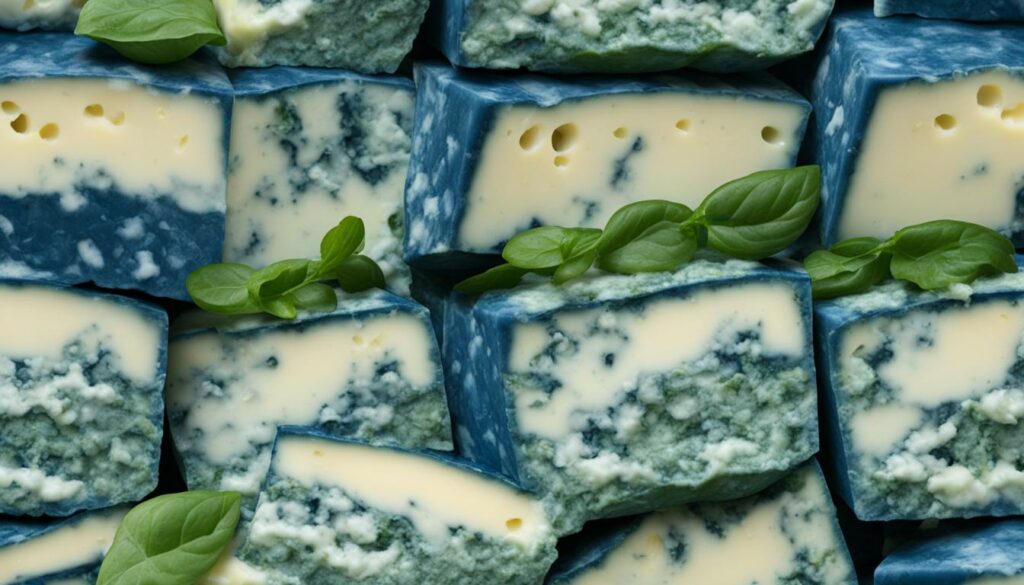
Blue cheese mold is what gives blue cheese its bold and distinctive flavors. This unique fungus adds a burst of flavor to the cheese, making it a beloved choice among cheese enthusiasts. It’s no wonder that blue cheese is often celebrated for its pungent and peppery taste.
When it comes to pairing blue cheese with other foods and beverages, it’s important to select ingredients that can stand up to its strong flavors. Opt for ingredients that complement the sharp tanginess of blue cheese, such as fruits, nuts, and honey. These flavorful additions enhance the overall taste experience and create a harmonious balance on your palate.
Flavor Pairing Suggestions for Blue Cheese:
- Spiced pear slices
- Walnuts or pecans
- Fig jam
- Honeycomb
- Red wine or craft beer
Blue cheese can also be a versatile ingredient in a variety of recipes. Its creamy and tangy profile adds depth of flavor to dressings, pasta dishes, and roasted meats. Whether you’re using it as a spread on a sandwich or incorporating it into a savory tart, blue cheese elevates any dish with its distinctive taste.
Unleash the full potential of blue cheese mold and explore the world of flavor pairing and cheese recipes that highlight its bold and unforgettable taste.
Understanding Blue Cheese Basics
When it comes to blue cheese, there is one name that stands out amongst the rest – Gorgonzola. But Gorgonzola is more than just the Italian word for blue cheese; it represents a unique style of cheese that is subject to specific regulations defined by European Union law. These cheese regulations, known as Protected Designation of Origin (PDO) and Protected Geographical Indication (PGI), play a significant role in dictating the production process and geographical restrictions for not only Gorgonzola but also other imported blue cheeses.
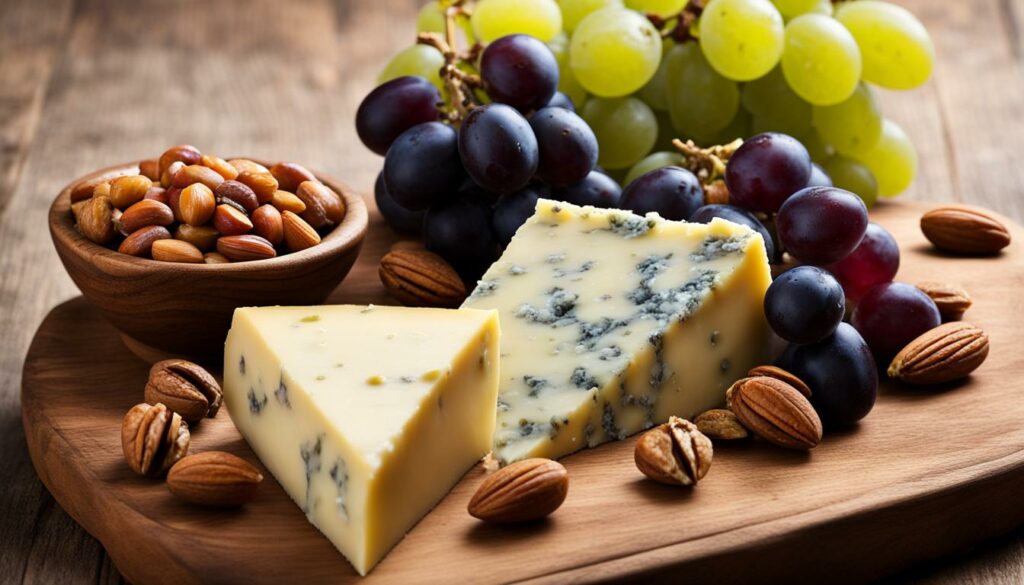
Each blue cheese variety can vary significantly in terms of flavor, texture, and intensity, with each style presenting its own distinctive qualities. From the crumbly and sharp Roquefort to the creamy and mellow Stilton, blue cheeses offer a diverse range of flavors and experiences.
Understanding these cheese regulations is crucial for anyone who appreciates the artistry and craftsmanship behind each blue cheese creation. The attention to detail and adherence to these guidelines ensure that every bite of blue cheese delivers an exceptional and authentic experience.
Gorgonzola – The Pride of Italian Blue Cheese
Originating from the Lombardy and Piedmont regions of Italy, Gorgonzola holds a special place in the world of blue cheese. This semi-soft cheese, characterized by its blue-green veins and creamy texture, has been produced for centuries using traditional techniques handed down through generations of cheesemakers.
According to the PDO and PGI regulations, Gorgonzola must be made from cow’s milk and aged for a minimum of 60 days. The production process involves inoculating the cheese with specific strains of Penicillium mold, which creates the distinctive blue-green marbling and imparts the unique flavor profile.
Gorgonzola is truly a cheese that embodies the essence of Italian tradition and craftsmanship. By adhering to these cheese regulations, cheesemakers ensure that every wheel of Gorgonzola that reaches your plate delivers an authentic taste of Italy.
| Blue Cheese Variety | Country of Origin | Flavor Profile | Texture |
|---|---|---|---|
| Roquefort | France | Sharp and tangy | Crumbly |
| Stilton | England | Mellow and robust | Creamy |
| Gorgonzola | Italy | Creamy and tangy | Semi-soft |
| Maytag Blue | United States | Sharp and buttery | Creamy |
Whether you’re savoring a slice of Gorgonzola on a cheese platter or exploring the world of blue cheese through various flavor pairings, it’s important to appreciate the craftsmanship and passion that go into creating these exceptional cheeses.
The Excellence of Wisconsin’s Blue Cheese Mold
When it comes to exceptional blue cheese, Wisconsin stands as a pinnacle of excellence. For over 180 years, its passionate cheesemakers have honed their craft, creating a wide range of delectable blue cheese varieties. From the bold and tangy cheddar blue to the luxurious and creamy quintuple cream Blue Jay, Wisconsin’s blue cheeses captivate the taste buds and delight cheese enthusiasts.
Wisconsin’s commitment to quality is evident in the numerous gold medals its blue cheese has garnered. This recognition solidifies its reputation as a top choice for those seeking the finest blue cheeses. When you see the Proudly Wisconsin Cheese badge, you can be assured that you’re selecting a blue cheese that has undergone meticulous craftsmanship and embodies the utmost in flavor and texture.
Immerse yourself in the excellence of Wisconsin’s blue cheese mold and savor the unforgettable taste of this artisanal delight.

| Blue Cheese Variety | Flavor Profile | Texture | Origin |
|---|---|---|---|
| Cheddar Blue | Bold and tangy | Firm and crumbly | Wisconsin |
| The Blue Jay | Creamy and luscious | Smooth and spreadable | Wisconsin |
| Roquefort | Sharp and tangy | Creamy and crumbly | France |
| Stilton | Mellow and robust | Creamy and crumbly | United Kingdom |
Discover the richness of Wisconsin’s blue cheese mold and elevate your culinary experiences with its bold and distinctive flavors.
Conclusion
Big Rock Blue Cheese offers a bold and unforgettable gourmet cheese experience. With its distinctive flavor and versatility in various dishes and pairings, it is a favorite among cheese lovers. Whether you’re indulging in its rich taste on a cheese platter or elevating your recipes with its creamy tanginess, Big Rock Blue Cheese is sure to delight your palate and leave a lasting impression.
Discover the world of blue cheese and immerse yourself in the bold flavors of this exquisite artisanal cheese. Its highly aromatic qualities and singularly delicious taste make it a top choice for connoisseurs. From the sharp tanginess of Roquefort to the mellow yet robust character of Stilton, blue cheese offers a diverse and delicious selection for cheese lovers.
Experience the tantalizing combination of flavors by pairing Big Rock Blue Cheese with other ingredients. Whether it’s the earthy sweetness of pears, the nuttiness of walnuts, or the subtle sweetness of honey, the possibilities are endless. Step into the captivating world of blue cheese and elevate your culinary creations with this exceptional cheese.
FAQ
What makes Big Rock Blue Cheese special?
Big Rock Blue Cheese is distinguished by its highly aromatic qualities and singularly delicious taste. It is considered one of the finest blue cheeses on the market.
How does blue cheese taste?
Blue cheese has a variety of flavors, ranging from sharp tanginess to mellow yet robust character. It offers a diverse and delicious selection for cheese lovers.
How can I use blue cheese in cooking?
Blue cheese can be crumbled over salads, melted into pasta sauces, or used to elevate gourmet burgers. It also pairs well with fruits, nuts, and certain types of wine and beer.
What determines the price of blue cheese?
The price of blue cheese is determined by factors such as type, origin, brand, and quality. Artisanal and specialty blue cheeses generally command a higher price compared to mass-produced options.
What is the nutritional value of blue cheese?
Blue cheese is a good source of protein and calcium and provides vitamins such as A and B12. However, it is higher in calories and sodium compared to some other cheese varieties, so moderation is key.
How does blue cheese mold contribute to the flavor?
Blue cheese mold injects bold and distinctive flavors into the cheese, making it a favorite among cheese lovers.
What foods and beverages pair well with blue cheese?
Ingredients with strong flavors such as fruits, nuts, honey, and dried fruits pair well with the sharp and peppery pungency of blue cheese. Blue cheese can also be used in various recipes, including dressings, pasta dishes, and roasted meats.
What is Gorgonzola and how is it different from other blue cheeses?
Gorgonzola is a unique style of blue cheese manufactured according to specific regulations defined by European Union law. These regulations dictate the production process and geographical restrictions for Gorgonzola and other imported blue cheeses, giving it its own distinct qualities.
What is special about Wisconsin’s blue cheese?
Wisconsin is known for producing exceptional blue cheese, with its cheesemakers perfecting the craft for over 180 years. The state is home to a wide range of blue cheese varieties, and Wisconsin’s blue cheese has garnered numerous gold medals, making it a top choice for cheese enthusiasts.

